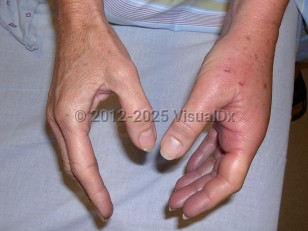Animal bite infection in Child
Alerts and Notices
Important News & Links
Synopsis

Animal bites to pediatric patients account for 1% of all visits to emergency rooms and urgent care centers. Most animal bites are caused by domesticated animals, with dog bites accounting for over 90% of cases, followed by cat bites at 8%. Human bites and other animals account for less than 2% of cases. In younger children, the face, neck, and head are most frequently involved, while the extremities are more often involved in older children. Most animal bites are unprovoked and occur during the spring and summer months by an animal that lives at the victim's residence. Infection is a frequent complication of animal bites, occurring in up to 50% of cat bites and 5%-15% of dog bites. While nontraditional pets and wild animals account for a small minority of pediatric animal bites, they may carry unique and significant infectious risks.
Infections secondary to animal bites include bacterial and viral etiologies. Factors that increase the risk of bacterial infection include crush injuries or puncture-like wounds (frequent with cats), a bite involving the hands or feet, an immunocompromised host (including diabetes), and preexisting impaired blood flow or lymphatic drainage to the bite area. A delay in seeking medical care (more than 12 hours for bites to the extremities or more than 24 hours for those to the head / neck), or improper initial bite management, is also associated with increased risk of infection.
Typical symptoms of an animal bite infection include pain, skin redness, warmth, swelling, and possibly purulent discharge. Lymphangitis, tissue abscess, or cellulitis may also be present. In more severe cases, regional adenopathy and fevers may develop. Tenosynovitis, septic arthritis, pyomyositis, and osteomyelitis may also occur in more severe cases.
The typical bacterial organisms involved are related to the offending animal's oral flora or skin flora from the victim. These include Streptococcus spp, Staphylococcus spp, Eikenella spp, Pasteurella multocida, Pasteurella spp, Bacteroides spp, and oral anaerobes. Most infections involve a mix of aerobic and anaerobic bacteria. Proper treatment with aggressive wound debridement, irrigation, and antimicrobial therapy is essential. Other notable infections include cat scratch (bite) fever and viral infections such as rabies.
Infections secondary to animal bites include bacterial and viral etiologies. Factors that increase the risk of bacterial infection include crush injuries or puncture-like wounds (frequent with cats), a bite involving the hands or feet, an immunocompromised host (including diabetes), and preexisting impaired blood flow or lymphatic drainage to the bite area. A delay in seeking medical care (more than 12 hours for bites to the extremities or more than 24 hours for those to the head / neck), or improper initial bite management, is also associated with increased risk of infection.
Typical symptoms of an animal bite infection include pain, skin redness, warmth, swelling, and possibly purulent discharge. Lymphangitis, tissue abscess, or cellulitis may also be present. In more severe cases, regional adenopathy and fevers may develop. Tenosynovitis, septic arthritis, pyomyositis, and osteomyelitis may also occur in more severe cases.
The typical bacterial organisms involved are related to the offending animal's oral flora or skin flora from the victim. These include Streptococcus spp, Staphylococcus spp, Eikenella spp, Pasteurella multocida, Pasteurella spp, Bacteroides spp, and oral anaerobes. Most infections involve a mix of aerobic and anaerobic bacteria. Proper treatment with aggressive wound debridement, irrigation, and antimicrobial therapy is essential. Other notable infections include cat scratch (bite) fever and viral infections such as rabies.
Codes
ICD10CM:
W55.81XA – Bitten by other mammals, initial encounter
SNOMEDCT:
399907009 – Animal bite wound
W55.81XA – Bitten by other mammals, initial encounter
SNOMEDCT:
399907009 – Animal bite wound
Look For
Subscription Required
Diagnostic Pearls
Subscription Required
Differential Diagnosis & Pitfalls

To perform a comparison, select diagnoses from the classic differential
Subscription Required
Best Tests
Subscription Required
Management Pearls
Subscription Required
Therapy
Subscription Required
References
Subscription Required
Last Reviewed:05/31/2021
Last Updated:02/09/2023
Last Updated:02/09/2023
Animal bite infection in Child

